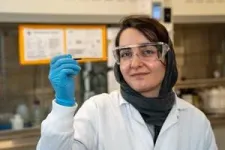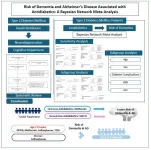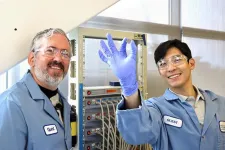(Press-News.org) The great promise of bacteriophages is that they naturally destroy bacteria, often in situations where antibiotics fail.
Until now, though, there has been no way to access them quickly and efficiently, especially in emergency cases of antibiotic resistant infections.
Researchers at McMaster University, working with a colleague from Université Laval, have developed a simple new way to store, identify, and share phages, making them more accessible to patients who need them.
“Bacteriophages are often talked about as a beacon of hope, but they are harder to use than traditional antibiotics, because there are so many varieties,” says lead investigator Zeinab Hosseinidoust, a McMaster chemical engineer who holds the Canada Research Chair in Bacteriophage Bioengineering.
The research team’s work is described in a paper published today in the journal Nature Communications.
Bacteriophages, or phages as they are called less formally, are beneficial viruses that could change the course of medicine and agriculture, especially as antibiotic resistance grows worldwide.
Each form of bacteriophage is specialized to attack a particular form of bacteria and nothing else, allowing phages to be directed specifically at infections while leaving beneficial bacteria alone.
A major challenge to harnessing their huge potential is creating easier and faster access to collections of phages.
“We don’t have a central library of phages to refer to when we need to use them. For the time being we have only decentralized local libraries of phages in places such as research labs and privately-owned clinics,” Hosseinidoust says. “What makes all this even more challenging is that we’ve been relying on the same basic tools and laborious lab techniques to handle and screen phages that our predecessors were using over 100 years ago when phages were first discovered.”
What adds to these critical barriers is that live phages must be suspended in vials of liquid and refrigerated or frozen, making storage cumbersome and hindering the efficient transport and sharing of phage collections.
The researchers have overcome these obstacles by developing a dry storage platform that plays the starring role in their user-friendly new system for quickly matching specific infections to the phages that can stop them.
Phages are natural, safe and effective. They are the most common organisms on Earth, inhabiting our bodies and all corners of the environment, but their potential benefits are still coming into view.
Even today, scientists have only identified a fraction of all the properties of phages.
Work to develop the potential of phages slowed significantly in the 1940s and 50s, when penicillin took the infection-control spotlight, particularly in the West. Though phages continued to be studied and deployed in central and eastern Europe, global interest in phages is growing once again now that the power of antibiotics is waning after generations of overuse.
The heart of the new system is a novel, pill-like medium that stores phages without refrigeration and combines them with an agent that produces a visible glow when a phage responds to a target infection.
Using this medium, the researchers can load a portable testing tray about the size of a paperback book with hundreds or even thousands of phage samples to check simultaneously in what is often an urgent search for a match.
The new technology enables phages to be stored at room temperature for months at a time until they are needed, combining a biobank and testing lab in one small package.
A user simply adds a sample of the target bacterium to each well of a pre-loaded well-plate, and any positive results become visible 30 minutes to two hours later.
“Having quick access to such portable testing labs would bring speed and order to the way things happen today, when a clinic or hospital facing an emergency situation is often forced to send a desperate call-out for candidate phages to test for possible use,” says co-investigator Tohid Didar, a mechanical engineer who holds the Canada Research Chair in NanoBiomaterials.
Fereshteh Bayat, a postdoctoral researcher in Didar and Hosseinidoust’s labs, had developed the concept of the technology as her PhD project.
“I have always wanted to contribute to something that has a positive impact on people’s lives,” Bayat says. “To see this materialize is very fulfilling.”
The McMaster researchers worked with Dr. Sylvain Moineau at Université Laval in Quebec City, which is home to the world’s largest biobank of referenced phages, and with their McMaster colleague Carlos Filipe who is an expert in the stabilization of biomolecules.
The new technology would also make it easier to use phages in non-medical applications, such as in agriculture, to control animal and plant infections, the researchers say. They are seeking partners to develop the technology for wide use.
“If everything moves forward to commercial application as we anticipate, this could revolutionize the way we use phages for different purposes,” says Didar.
END
Researchers develop a way to make lifesaving phages accessible, transportable and much easier to use
When antibiotics fail, bacteriophages can often save lives, but determining which ones will work and sourcing them is haphazard
2024-07-11
ELSE PRESS RELEASES FROM THIS DATE:
MD Anderson Research Highlights for July 11, 2024
2024-07-11
HOUSTON ― The University of Texas MD Anderson Cancer Center’s Research Highlights provides a glimpse into recent basic, translational and clinical cancer research from MD Anderson experts. These advances are made possible through seamless collaboration between MD Anderson’s world-leading clinicians and scientists, bringing discoveries from the lab to the clinic and back.
Recent developments at MD Anderson offer insights into mechanisms regulating metabolic programming and cellular senescence, ...
Metformin and other antidiabetic drugs can help reduce the risk of dementia in patients with type 2 diabetes
2024-07-11
Ann Arbor, July 11, 2024 – Investigators analyzing the potential cognitive effects of antidiabetic medications in records of more than 1.5 million patients with type 2 diabetes mellitus (T2DM) found risks of dementia and Alzheimer’s disease (AD) were significantly lower in patients treated with metformin and sodium glucose co-transporter-2 inhibitors (SGLT-2i) compared to other antidiabetic drugs. Their results appear in the American Journal of Preventive Medicine, published by Elsevier.
T2DM has become ...
First ever 3D reconstruction of 52,000-year-old woolly mammoth chromosomes thanks to serendipitously freeze-dried skin
2024-07-11
An international research team has assembled the genome and 3D chromosomal structures of a 52,000-year-old woolly mammoth—the first time such a feat has been achieved for any ancient DNA sample. The fossilized chromosomes, which are around a million times longer than most ancient DNA fragments, provide insight into how the mammoth’s genome was organized within its living cells and which genes were active within the skin tissue from which the DNA was extracted. This unprecedented level of structural detail was retained because ...
Climate change: Thick sea ice flowing from Arctic Ocean shortening shipping season in Northwest Passage
2024-07-11
An increased amount of thick sea ice flowing south from the Arctic Ocean shortened the ice-free shipping season in several parts of the Northwest Passage between 2007 and 2021, according to an analysis in Communications Earth & Environment. The authors suggest this could mean the Northwest Passage is unlikely to become a viable alternative to traditional shipping routes, despite previous hopes that it may become viable due to global warming.
The Northwest Passage (NWP) is a commercial shipping route connecting the Atlantic and Pacific Oceans that runs through the Arctic Circle north of North America. Through the Canadian ...
State gun laws have mixed impact on suicide and homicide rates
2024-07-11
DURHAM, N.C. – Certain state gun laws are associated with decreased suicide rates for children under age 18, but the laws have little influence on homicide rates, according to a study from Duke Health researchers examining the relationship between gun laws and child deaths.
Since 2020, firearms rank as the leading cause of death among U.S. children ages 1-18, raising the need for research to help guide prevention efforts.
“Our analysis of suicide and homicide mortality data from ...
Treatment approaches for opioid use disorder offered in us substance use treatment facilities
2024-07-11
About The Study: Substance use treatment facilities reported significant gaps in provision of effective treatments for opioid use disorder (OUD). More than one-third of facilities did not offer medications for OUD (MOUD) and less than half offered multiple MOUD types, limiting MOUD treatment options for patients and clinicians.
Corresponding Author: To contact the corresponding author, Tae Woo Park, M.D., M.Sc., email parkt4@upmc.edu.
To access the embargoed study: Visit our For The Media website at this link https://media.jamanetwork.com/
(doi:10.1001/jama.2024.11913)
Editor’s ...
Secondhand nicotine absorption from E-cigarette vapor vs tobacco smoke in children
2024-07-11
About The Study: In this cross-sectional study of U.S. children, nicotine absorption was much lower in children who were exposed to secondhand vapor versus secondhand smoke, but higher than in those exposed to neither. These findings suggest that switching from smoking to vaping indoors may substantially reduce, but not eliminate, children’s secondhand exposure to nicotine and other noxious substances.
Corresponding Author: To contact the corresponding author, Harry Tattan-Birch, Ph.D., email h.tattan-birch@ucl.ac.uk.
To ...
Long-term outcomes of self-fit vs audiologist-fit hearing aids
2024-07-11
About The Study: This comparative effectiveness research study demonstrated that self-fit over-the-counter hearing aids can offer comparable long-term benefits to audiologist-fit hearing aids for individuals with mild to moderate hearing loss.
Corresponding Author: To contact the corresponding author, Karina C. De Sousa, Ph.D., email karina.swanepoel@up.ac.za.
To access the embargoed study: Visit our For The Media website at this link https://media.jamanetwork.com/
(doi:10.1001/jamaoto.2024.1825)
Editor’s Note: Please ...
Second-hand vaping exposure very low compared to second-hand smoking
2024-07-11
Children exposed to vaping indoors absorb less than one seventh the amount of nicotine as children who are exposed to indoor smoking, but more than those exposed to neither, according to a new study led by UCL researchers.
The study, published in JAMA Network Open and funded by Cancer Research UK, looked at blood tests and survey data for 1,777 children aged three to 11 in the United States.
The researchers said that second-hand exposure to harmful substances in e-cigarettes would likely be much lower still, as e-cigarettes deliver similar levels of nicotine to tobacco but contain only a fraction of the toxicants and ...
Biological science helps fuel the future of electric air travel
2024-07-11
– By William Ferguson
When it comes to figuring out why electric aircraft batteries lose power over time, one typically wouldn’t think to turn to a decades-old approach biologists use to study the structure and function of components in living organisms. However, it turns out that omics, a field that helped scientists unravel the secrets of the human genome, could also soon play a key role in making carbon-free air travel a reality.
In a new study in the journal Joule, a team of researchers led ...
LAST 30 PRESS RELEASES:
Mysterious iron ‘bar’ discovered in famous nebula
World-first tool reduces harmful engagement with AI-generated explicit images
Learning about public consensus on climate change does little to boost people’s support for action, study shows
Sylvester Cancer Tip Sheet for January 2026
The Global Ocean Ship-Based Hydrographic Investigations Program (GO-SHIP) receives the Ocean Observing Team Award
Elva Escobar Briones selected for The Oceanography Society Mentoring Award
Why a life-threatening sedative is being prescribed more often for seniors
Findings suggest that certain medications for Type 2 diabetes reduce risk of dementia
UC Riverside scientists win 2025 Buchalter Cosmology Prize
SETI Institute opens call for nominations for the 2026 Tarter Award
Novel theranostic model shows curative potential for gastric and pancreatic tumors
How beige fat keeps blood pressure in check
Fossils reveal ‘latitudinal traps’ that increased extinction risk for marine species
Review: The opportunities and risks of AI in mental health research and care
New map reveals features of Antarctic’s ice-covered landscape
Beige fat promotes healthy vascular function and blood pressure in mice
Chronic low-dose pesticide exposure reduces the life span of wild lake fish, China-based study shows
Tiny earthquakes reveal hidden faults under Northern California
Long-term pesticide exposure accelerates aging and shortens lifespan in fish
Professor Tae-Woo Lee's research group develops groundbreaking perovskite display technology demonstrating the highest efficiency and industry-level operational lifetime
The “broker” family helps tidy up the cell
Ecology: Mummified cheetahs discovery gives hope for species’ Arabic reintroduction
Researchers survey the ADHD coaching boom
Air pollution and cardiac remodeling and function in patients with breast cancer
Risk of suicide in patients with traumatic injuries
Post–intensive care syndrome
The lifesaving potential of opioid abatement funds
The Frontiers of Knowledge Award goes to Allan MacDonald and Pablo Jarillo-Herrero for their discovery of the “magic angle” enabling science to transform and control the behavior of new materials
Discovery reveals how keto diet can prevent seizures when drugs fail
JMIR Publications and Sikt announce pilot flat-fee unlimited open access partnership
[Press-News.org] Researchers develop a way to make lifesaving phages accessible, transportable and much easier to useWhen antibiotics fail, bacteriophages can often save lives, but determining which ones will work and sourcing them is haphazard





